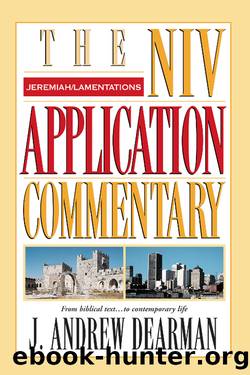The NIV Application Commentary: Jeremiah and Lamentations by J. Andrew Dearman

Author:J. Andrew Dearman [Dearman, J. Andrew]
Language: eng
Format: epub
Tags: REL006060 Religion / Biblical Commentary / Old Testament
ISBN: 9780310872832
Publisher: HarperCollins Christian Publishing
Published: 2014-05-07T16:00:00+00:00
Jeremiah 30–33
Introduction to Jeremiah 30–33
THESE FOUR CHAPTERS comprise a distinct subsection in Jeremiah. They are not, however, a simple unity. Chapters 30–31 are largely poetry, while 32–33 are prose. Chapters 30–31 are often called by interpreters the “Book of Consolation” or the “Book of Hope”1 because they contain proclamations of Israel and Judah’s restoration to the Promised Land. Restoration—or better said, the creation of a new relationship with the Lord—is also central here. The same restoration-oriented hope is part of chapters 32–33, so that their interpretation is linked with the two previous chapters. Nevertheless, no concrete setting in Jeremiah’s ministry is given for the proclamation of chapters 30–31 (see below) as there is with chapters 32–33. The latter are set in the last days of the Judean state (587 B.C.), the tenth year of Zedekiah and the eighteenth of Nebuchadnezzar (32:1; 33:1).
Since there is a range of interpretive possibilities regarding Jeremiah’s future hope, it is best to list the most common of them and to comment on them briefly at the outset of this subsection. Individual details are discussed more fully with the specific chapter.
(1) Some modern interpreters have concluded that major portions of the hopeful prophecies in the book originated not with Jeremiah but with his editors in the later exilic period, as deported Judeans looked for the possibility of restoration to their homeland.2 According to some proponents of this view, the historical Jeremiah was essentially a prophet of doom, or an individual so far removed from the book that bears his name that the origin of most of these restoration prophecies comes from people in exile (and perhaps even in the postexilic period) who hoped for future change.
One may begin a response with the affirmation that there is no reason, a priori, why those who edited and produced the book of Jeremiah could not also have contributed prophecies to the finished product. After all, if God can call Jeremiah as a prophet, then God can also use editors! The question is simply one of evaluating the relevant evidence for secondary material and weighing the balance of probability.
As noted in the introduction, it seems more likely to the present writer that Jeremiah’s circle of supporters reworked and updated material that originated with the prophet himself, and less likely that some of the most creative and compelling material in all the book originated with these anonymous laborers. Perhaps this circle of supporters even had the assistance of the prophet himself in the earlier stages of editing before the book reached its final form. As editors, this circle would have arranged the material in line with the hope enunciated by Jeremiah himself, even if the sequencing of materials and the final form of the book came after the prophet’s death.
Clearly the destruction of Jerusalem and the deportation of many of Judah’s inhabitants impact the entire book of Jeremiah, including the hopeful oracles in chapters 30–33. In final form the restoration texts in this section are addressed to those Judeans who lived after Judah’s demise and Jerusalem’s destruction.
Download
This site does not store any files on its server. We only index and link to content provided by other sites. Please contact the content providers to delete copyright contents if any and email us, we'll remove relevant links or contents immediately.
| New Testament | Old Testament |
The Five People You Meet in Heaven by Mitch Albom(2859)
Name Book, The: Over 10,000 Names--Their Meanings, Origins, and Spiritual Significance by Astoria Dorothy(2505)
Real Sex by Lauren F. Winner(2496)
The Holy Spirit by Billy Graham(2442)
The Secret Power of Speaking God's Word by Joyce Meyer(2268)
How The Mind Works by Steven Pinker(2240)
0041152001443424520 .pdf by Unknown(2239)
ESV Study Bible by Crossway(2176)
Ancient Worlds by Michael Scott(2119)
The Meaning of the Library by unknow(2081)
The Gnostic Gospels by Pagels Elaine(2047)
Churchill by Paul Johnson(2024)
The ESV Study Bible by Crossway Bibles(1994)
MOSES THE EGYPTIAN by Jan Assmann(1984)
Jesus by Paul Johnson(1900)
Ancient Near Eastern Thought and the Old Testament by John H. Walton(1861)
The Nativity by Geza Vermes(1858)
The Complete Dead Sea Scrolls in English (7th Edition) (Penguin Classics) by Geza Vermes(1855)
City of Stairs by Robert Jackson Bennett(1849)
